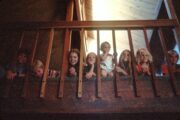
As babies grow into toddlers, curiosity becomes their driving force. Every corner of the home becomes an adventure playground for them, and stairs are often one of the most fascinating yet dangerous areas. Parents may not realize how risky staircases can be until their little one begins crawling, climbing, or attempting to walk. While stairs are a normal part of a home, they pose significant hazards for infants and toddlers if not properly secured.
In this blog, we’ll explore the hidden dangers of stairs, why children are so vulnerable, and the steps parents can take to make staircases safer.
Why Stairs Are So Dangerous for Young Children
1. Lack of Balance and Coordination
Babies and toddlers are still learning to control their bodies. Their sense of balance and coordination is undeveloped, making them prone to tripping or tumbling when approaching stairs. Even one misstep can result in serious injuries.
2. Natural Curiosity
Children are drawn to stairs because they seem like a challenge. Crawling up or sliding down feels like play, but they are unaware of the risks. Their adventurous spirit can quickly lead them into danger.
3. Unpredictable Movements
Toddlers are often impulsive. They may run toward the stairs or try to climb without any warning. This unpredictability makes constant supervision essential.
4. Hard Surfaces Increase Injury Risk
Most staircases are made of hard materials such as wood, stone, or concrete. A fall on these surfaces can lead to head injuries, broken bones, or severe bruises.
Common Accidents on Stairs
Understanding the types of accidents that happen on stairs helps highlight the importance of safety precautions.
- Slips and Falls: Babies crawling on smooth steps can easily slip, especially if socks or slippery clothing is involved.
- Rolling Downstairs: A toddler who loses balance at the top of a staircase can tumble down, leading to severe injuries.
- Head Injuries: Falling forward or backward often results in direct impact to the head.
- Trapped Limbs: Open stair rails can cause hands, feet, or even heads to get stuck, leading to distress and injury.
- Playing with Objects on Stairs: A toddler may try to drag toys onto stairs, increasing tripping hazards.
Potential Injuries from Stair Accidents
The consequences of stair accidents can be severe. According to pediatric safety studies, falls on stairs are one of the leading causes of non-fatal injuries in children under five. Some of the injuries include:
- Head trauma (concussions, skull fractures)
- Broken bones (arms, legs, collarbones)
- Cuts and bruises
- Sprains and strains
- Emotional distress (fear of walking after a fall)
These risks make it clear that stair safety should be a top priority for families with young children.
Signs That Your Home Needs Stair Safety Measures
Parents should act proactively, but there are specific signs that signal immediate action is necessary:
- Your baby has started crawling or pulling themselves up.
- Your toddler is trying to walk independently.
- Stairs are centrally located and frequently accessed.
- Stairs lack protective gates or railings.
- The steps are slippery or have open sides.
If any of these apply, it’s time to put preventive measures in place.
How to Make Stairs Safer for Babies and Toddlers
1. Install Baby Gates
Baby gates are the most effective barrier against stair accidents. They should be:
- Pressure-mounted gates for the bottom of the stairs.
- Hardware-mounted gates for the top, as they are more secure.
Always ensure the gate closes properly and is tall enough to prevent climbing.
2. Use Non-Slip Stair Covers
Carpet runners or non-slip adhesive stair treads reduce the chances of slipping. Avoid smooth or polished finishes that can be dangerous for small feet.
3. Supervise Constantly
No matter how many safety features you install, supervision remains essential. Never leave babies or toddlers unattended near stairs.
4. Teach Stair Safety Early
As your toddler grows, teach them to:
- Hold onto the railing.
- Take one step at a time.
- Sit and slide down on their bottoms until they’re ready to walk stairs safely.
5. Secure Railings
Check for gaps in stair railings. If the gaps are too wide, children might slip through or get stuck. Installing plexiglass or railing guards can help.
6. Remove Clutter from Stairs
Keep toys, shoes, and household items off stairs to prevent tripping hazards.
7. Good Lighting
Ensure that staircases are well-lit, reducing the chance of accidents at night or in dim conditions.
Psychological Impact of Stair Accidents
Beyond physical harm, stair accidents can leave emotional effects on children and parents.
- Children may develop a fear of climbing or walking after a fall, delaying motor skill development.
- Parents may experience guilt, anxiety, or hypervigilance.
Preventive measures not only protect physical health but also preserve emotional well-being.
When to Seek Medical Help
If your child has fallen on the stairs, you should seek immediate medical attention if they:
- Lose consciousness, even briefly.
- Show signs of confusion, vomiting, or drowsiness.
- Have visible head swelling or bleeding.
- Are unable to move a limb or show signs of severe pain.
Never assume a stair fall is harmless. It’s always better to consult a doctor.
Final Thoughts
Stairs are one of the most underestimated hazards for babies and toddlers. While they may appear harmless to adults, they can pose life-threatening dangers to curious and unsteady little explorers. From head injuries to emotional trauma, stair accidents can be devastating. However, with preventive measures like baby gates, non-slip surfaces, supervision, and early education, parents can drastically reduce risks.
Creating a safe environment ensures that your baby or toddler can explore and grow without unnecessary danger. In the end, stair safety isn’t just about protecting children from accidents, it’s about giving parents peace of mind and children the freedom to learn and develop safely.


